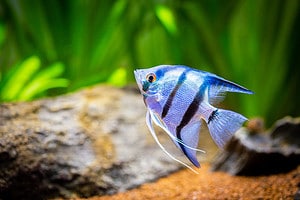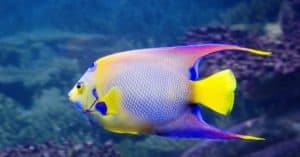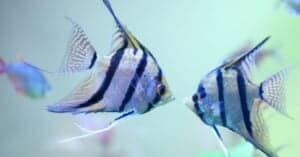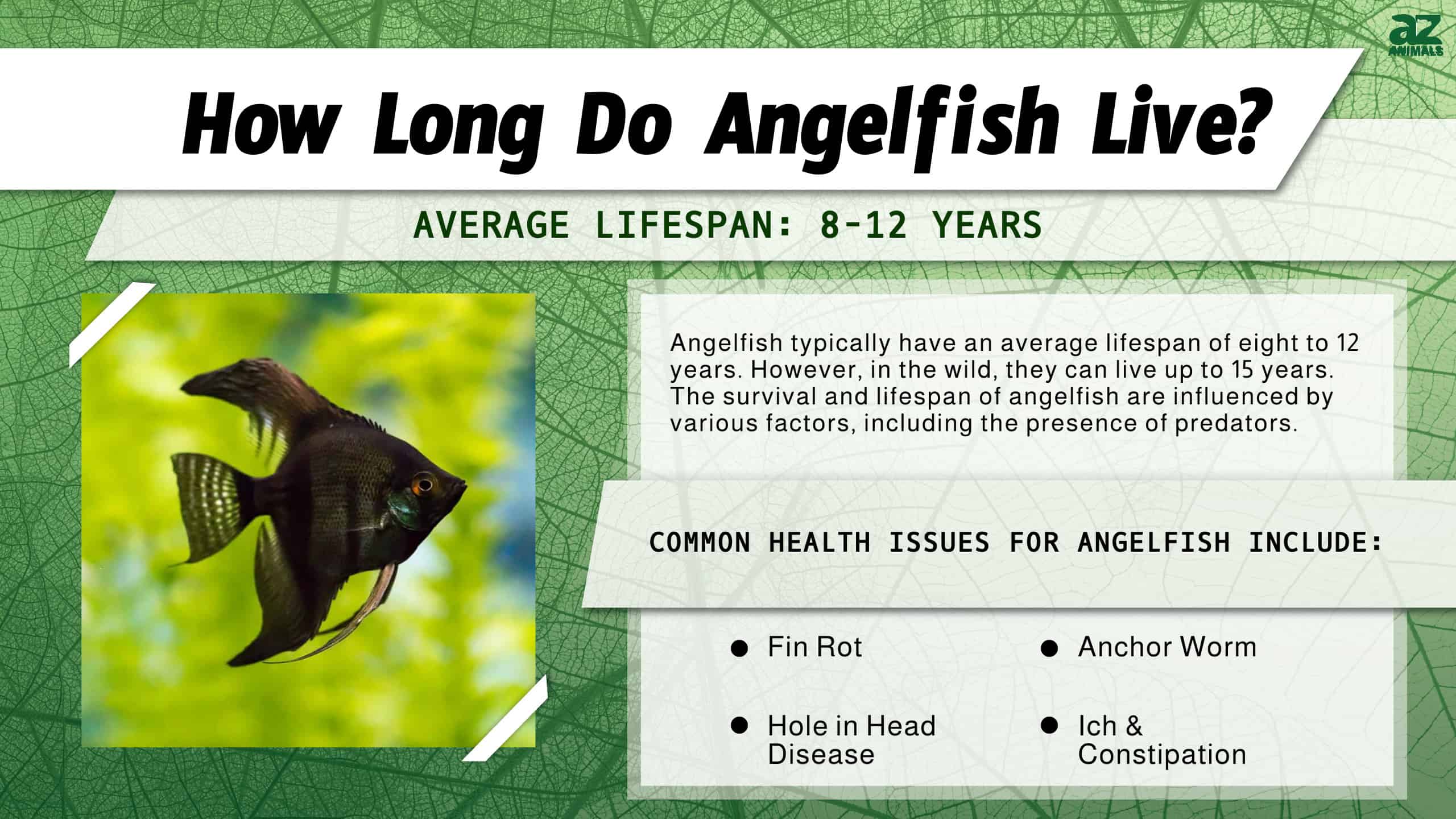
Angelfish are one of the most popular tropical aquarium fish. They are well-known for their unique shape and striped camouflage coloration. And because they do well with other same-sized fish, they are the perfect addition to exotic aquariums. Angelfish are also great for beginners because they are easy to care for, and they tolerate many parameters. But how long do angelfish live? Discover the angelfish lifespan, learn about their life cycle, and find out how to extend their life.
Angelfish: A Quick Overview
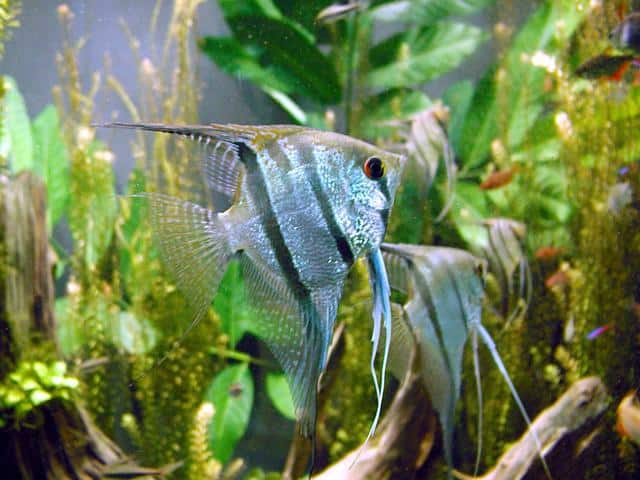
Freshwater angelfish are one of the most popular cichlids kept in aquariums
©mendel / Creative Commons – License
The angelfish is a genus of tropical freshwater fish featuring three recognized species: Pterophyllum allum, Pterophyllum leopoldi, and Pterophyllum scalare. These fish are from the Cichlidae family. And they are native to South America. These species originated in the Amazon and Orinoco Basins, including several rivers in Northeast South America.
Angelfish are one of the most popular cichlids kept in warm freshwater aquariums. They have a unique and elegant shape and feature beautiful iridescent colors and contrasting stripes. For aquarium hobbyists, the angelfish is a graceful specimen that can grow quite large. While considered peaceful, angelfish can be aggressive towards each other. And they are opportunistic feeders who will eat anything they can easily fit into their mouths.
Wild caught angelfish are prized in the aquarium world. But most are acquired through captive breeding. Pterophyllum scalare is the most readily available and popular species. And Pterophyllum leopoldi is the rarest. Leopoldi is the smallest and known for being the most aggressive out of all three species.
The Average Angelfish Lifespan

How long do angelfish live? 8 to 12 years on average
©Saad315/Shutterstock.com
On average, the angelfish live eight to 12 years. However, they can live up to 15 years in the wild. But many factors play into their survival. Wild angelfish also have to live with predators, which can greatly reduce their population and prevent them from reaching their maximum lifespan. In South America, these fish have to escape bigger fish, giant otters, and many birds.
These freshwater fish often live much shorter lives than capable when held in captivity. Without the proper space, water quality, and other factors, the angelfish may only live for a few years. But they can easily reach or exceed their lifespan in a controlled environment as long as proper measures are taken.
The first thing you should do to extend your pet fish’s life is to pick a healthy angelfish before bringing it home. When picking a young angelfish, look for ones that appear strong and thick. Avoid those that look too thin or have cloudy eyes. And if you can see them being fed, pick the most aggressive of the bunch. Also, ensure the angelfish has straight fins with no kinks or curves.
The Angelfish Life Cycle: Explained
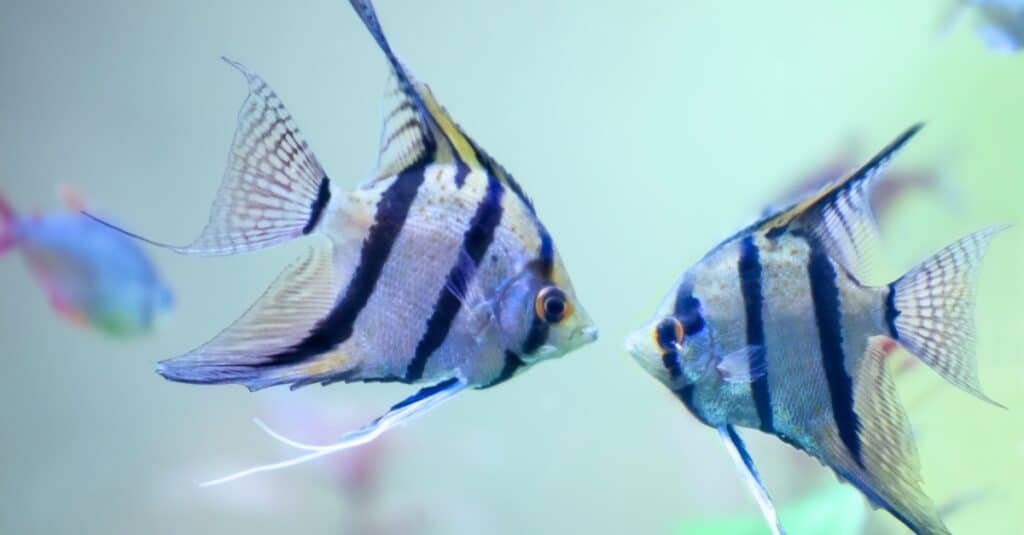
Silver angelfish enjoy living alongside other members of their species.
©iStock.com/TatianaMironenko
Angelfish reach sexual maturity between six and 12 months and are fairly easy to breed in an aquarium, except for P. altum. An angelfish pair can spawn up to once a week, and they prepare by clearing a suitable area from organic material.
Once the female deposits the eggs, the male fertilizes them. For each spawning process, the pair can produce anywhere from 100 to 1,200 eggs. While some parents eat their first couple batches of eggs, others get the hang of it pretty easily. You can see them caring for the eggs by swimming close to them and fanning them for circulation.
After a few days, the eggs hatch but remain attached to the yolk sac. At this stage, they are called fry and can survive by hiding from bigger fish and consuming their yolk sacs. Around one week, the fry detaches from the substrate and becomes free-swimming. And they can be fed live food at this point, such as baby brine shrimp.
How to Extend the Life of Your Pet Angelfish
While freshwater angelfish can live up to 12 years in an aquarium, there are certain measures you should take to reach their maximum longevity.
- Mimic the angelfish’s natural environment. Add broad-leaf plants and a floating plant cover in their tank. You can also place gravel and driftwood to further make them feel at home. Angelfish use plants for protection and reproduction. But they are also useful stress relievers for these fish.
- Ensure the tank is at least 55 gallons, preferably larger. They also do well in tall aquariums, which complement their body shape. And their water temperature should never fall below 78℉ or go above 84℉
- Feed them a natural diet close to what they would eat in the wild. Angelfish eat both plants and meat, so you must ensure they have a balanced diet. You can feed them fish flakes, live brine shrimp, spinach, and blood worms.
- Don’t keep your angelfish alone. Provide them with suitable tank mates.
The photo featured at the top of this post is © Saad315/Shutterstock.com
Thank you for reading! Have some feedback for us? Contact the AZ Animals editorial team.



